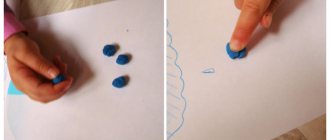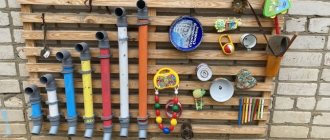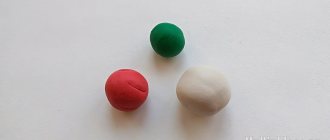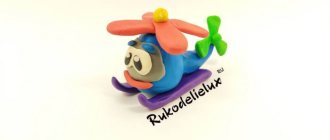07.08.2019
Modeling from plasticine step by step is the best educational technique for preschool children (from 2-3 to 7 years old)! Children love modeling with clay because they can create anything!
Most of all, children love to sculpt: animals, people, cars, cities. Nowadays it is very popular to sculpt Smeshariki, unicorns, cats, hedgehogs and dragons. Sculpting is very useful. Step-by-step modeling develops creative thinking, imagination, fine motor skills, speech, and logical thinking several times faster.
Children from 3 to 7 years old are especially passionate about modeling. Therefore, we have selected interesting craft ideas that are very popular among children. Stock up on plasticine of different colors to make it even more interesting for your child!
How to make a caterpillar and a bee step by step
How to make a ladybug
Snail step by step for children (spiral modeling)
How to make a teddy bear
An interesting idea for sculpting: a bird in a nest
We sculpt flowers and compositions step by step
How to make a car from plasticine
Bicycle step by step
Modeling should be interesting for a child. Therefore, choose the most interesting ideas for modeling. Let the child choose what he will sculpt. When the baby is engaged, discomfort, excitement and anxiety go away. When a child creates a favorite cartoon animal, be it a bunny or a kitten, a giraffe or a unicorn, he feels good and proud of his achievements. Therefore, mommies, do not forget to praise your baby for any achievement!
GCD move:
Educator: Guys! Do you know who came to visit us today?
The teacher pulls out a big hedgehog
. The children gather in the middle of the room.
The children answer.
Educator: Hedgehog
!
Children looking at a hedgehog
.
Educator: Guys, hedgehog
came to us from the forest. He lives in the forest.
Educator: He is friends with bears, bunnies, and squirrels. And he is afraid of the wolf and the fox. When he sees danger, the hedgehog curls up into a prickly ball and no one can touch him.
Educator: What does he like to eat? The children answer.
Educator: Hedgehog loves mushrooms
, apples, pears and milk
Educator: At home, the hedgehog drinks milk. In winter, the hedgehog sleeps in his hole. That is, in your house.
Educator: Guys, you can’t offend animals. We must love them and treat them with reverence. Look how sad the hedgehog is
.
Let's cheer him up. Children's answers The teacher reads a poem, and the children repeat after him
The hedgehog stomped along the path
And he carried mushrooms on his back (walking in place)
The hedgehog stomped slowly
Quietly the leaves rustle
(we rustle with our palms)
And a bunny gallops towards us,
Long-eared one, jump around.
Something clever in the garden
I got hold of a sideways carrot (jumping in place)
.
Educator: Guys, I invite you to the table. Children sit at tables where there are blanks with the image of a hedgehog without needles
. –
Educator: These are the pictures with the image of a hedgehog lying in front of you
.
Consider the hedgehog. Oh! He's kind of weird! The hedgehog is missing something
. Children's answers.
Educator: That's right, there are no needles! Let's quickly give the hedgehog some needles
!
Like this! The teacher shows how to make hedgehog needles. The teacher invites the children to make plasticine balls for needles: pinch off small pieces of plasticine with the thumb and forefinger of their right hand and roll them into balls. Children roll 2-4 balls each (the rest of the balls are prepared in advance)
.
Then invite the children to place a plasticine ball over the outline of the hedgehog's
, press it with their finger and pull their finger down.
Educator: It turned out to be a needle! Let's give the hedgehog a lot of needles
!
on a hedgehog
. Children and teacher make needles. The teacher helps those who are not doing well. When the work is ready, everyone admires their pictures and the pictures of their comrades.
Educator: Now I suggest you turn into hedgehogs. The teacher shows the kids how to draw a hedgehog
, clasping your fingers together.
The teacher reads a poem, and while reading, the children repeat
the teacher’s movements.
The little hedgehog is frozen
(press your fingers -
the hedgehog removes the needles )
And curled up into a ball.
The sun warmed the hedgehog
(Straighten your fingers -
the hedgehog showed the spines )
The hedgehog turned around
.
The teacher praises the children for their work and says that we will place our hedgehogs at the exhibition so that they will please us and their parents.
Educator: And now it’s time to say goodbye to our hedgehog
, he goes back to his forest.
Children say goodbye to the hedgehog
.
Educator: Guys, we helped make the hedgehog
?
Did you help the hedgehog?
How did we help him?
Publications on the topic:
Notes on sculpting in the second junior group “Who visited us in our garden?” Integration of educational areas: “Cognition”, “Reading fiction”, “Artistic creativity”, “Communication”, “Socialization”.
Abstract of GCD in the second junior group for modeling "Owl" Educational area: Artistic and aesthetic development Integration of educational areas: Artistic, aesthetic, cognitive,.
Abstract of educational activities for modeling in the second junior group “Multi-colored balls for a hedgehog” Integration of educational areas: “Cognitive development”, “Artistic and aesthetic development”. Objectives: 1. Educational: - teach.
Tasks. Develop plot-game concept and imagination. Make chicken figures from individual lumps. Using pulling and pinching techniques.
Program content: Learn to convey the shape of an object (sparrow, divide plasticine into two unequal parts, learn to fasten two parts in order to...
Notes on object modeling in the second junior group “Gift for Dad” Purpose: to make a gift for Dad (tie). Objectives: Educational: Reinforce modeling techniques: develop the ability to separate a piece of plasticine.
Plasticine is a magical material with which you can make incredibly beautiful figures. These can be fairy-tale and cartoon characters, buildings and plants. Animals made from plasticine deserve special attention. For children, modeling will be an incredibly exciting and educational activity, from which it is impossible to escape for a minute.
Plasticine is a magical material with which you can make incredibly beautiful figures.
Sea inhabitants made from plasticine turn out to be extraordinarily beautiful.
Even a child can make such crafts with his own hands. Making a crab requires just a little attention and patience.
Sea inhabitants made from plasticine turn out to be extraordinarily beautiful
Sequencing:
- Make blanks for the body, a pair of claws and eight legs.
- The largest ball from which the body will be made needs to be pressed down a little.
- To make the paws, make sticks from eight blanks.
- Attach four tabs on one side and four more on the other.
- Form claws from the two remaining blanks and attach them to the crab's front legs.
- Place small circles of a lighter material on the body.
- Make eyes.
How to sculpt animals, video
How to make a bunny
How to make a teddy bear
The bear cub is a favorite animal of small children. They will be happy to repeat the modeling lesson. Follow the instructions!
We sculpt wild animals step by step
Wild animals are of particular interest to children, since not everyone gets to meet them in real life. We have to be content with their depiction in the pictures. That is why sculpting a lion cub from plasticine will not only be exciting, but also educational.
Wild animals are of particular interest to children, since not everyone gets to meet them in real life.
Work progress step by step:
- Make a circle from the yellow mass and attach a couple of small parts to it, forming the cheeks of the animal.
- Make a nose out of brown material and secure it between the cheeks.
- Attach eyes a little above the cheeks.
- Make a teardrop-shaped body and slightly extend the tip of this piece.
- Using a match, connect the head to the body.
- Form a lot of brown circles from brown material and fix them on the animal’s head - you get a mane.
- Now mold the paws and stick three small orange circles on each of them.
- Attach these parts to the body.
Make a yellow ponytail with an orange tassel at the tip and stick it to the craft.
Mental and personal development while sculpting
When doing sculpting step by step, do it in a fun and playful way. Create a story for the beast you create, and then act it out. Use ideas from fairy tales and cartoons, and act out stories from everyday life.
What do you need for a modeling lesson?
You need high-quality plasticine. For kids, choose very soft plasticine. If it is difficult for the baby to sculpt awkwardly, then his interest in such an activity will quickly pass.
Tools for modeling from plasticine:
- modeling board;
- stacks;
- rolling pins, including those with patterns;
- molds for modeling.
How to teach children to sculpt?
Many parents think that children will begin to sculpt and develop on their own. This is wrong. You will need to be shown how to do it, go through basic lessons. In the future, the child will come up with his own characters, but initially show him how to do it.
Learn how to sculpt basic shapes:
- ball;
- egg (ellipsoid);
- hemisphere;
- cake;
- sausage;
- cylinder;
- cone;
- brick;
- tourniquet;
- spiral.
After this, mold the figures step by step. Choose an interesting animal and make it together. Help the child, praise him!
Modeling in this age group usually takes no more than 20 minutes.
Plasticine pets
In order to start sculpting animals, you must first decide what kind of animal you want to depict.
Try to clearly imagine the image that will be embodied using plasticine. Children, as a rule, choose pets to sculpt. This is due to the fact that they see them quite often, unlike wild ones. Usually, any animal begins to be sculpted from the head. To create it, you need one large ball for the base and two smaller ones for the ears. Next, the required shape is created from these balls.
Eye placement is also important. They should be positioned so that the animal is looking directly at you. Balls are also prepared for the body, paws and tail, if, of course, there is one. An important point will be the connection of all elements into one whole. You can use matches or toothpicks for this. If you use medium-soft plasticine for modeling, you can subsequently play with these animals, creating various storylines involving pets.
Peppa Pig made from plasticine
For many children, Peppa Pig has become a favorite cartoon character. They will certainly be interested in making it out of plasticine themselves. Moreover, this work is not at all difficult.
Manufacturing stages:
- Roll the red and pink mixture into balls.
- Press the red piece onto the work surface, then use your fingers to pull out the flat side to form the hem of the dress.
- Make a small hole on top.
- Deform the pink ball slightly, extending the wide nose.
- Stick eyes on top.
- Decorate the nickel and mouth with red stripes.
- Glue the ears to the top of the head.
- Connect the head and torso.
- Mold the arms and attach them to the body.
Glue the tail to the back.
Funny animals from the zoo: monkey, snake, sloth
You can create your own zoo from ordinary plasticine. A variety of forest, wild and domestic animals will happily settle in it. Modeling will bring a lot of fun, and the made figures will be excellent toys for kids.
How to make a monkey: step-by-step instructions
An unusual monkey is made from brown and yellow plasticine mass.
It is molded according to the following scheme:
- Prepare a part for the head from a brown mass and a couple of small yellow elements to form the face.
- Attach yellow cakes to the head, placing them as closely as possible to each other.
- Draw eyes, mouth, nose and wrinkles in a stack.
- Make ears.
- Make a body in the shape of an egg and stick a yellow cake to it.
- Using a match, connect the body to the head.
- Make four long tubes from the brown mass.
- Attach yellow circles to each of the tubes and make cuts on them in a stack.
- Attach the monkey's limbs to the main part.
Monkeys come in different colors
Finally, attach a long tail to the animal.
Snake: sculpting in stages
A very realistic snake is made according to the following instructions:
- Roll the plasticine mass into a sausage of the required length.
- Select the head, giving more volume in this place.
- Draw the eyes and nostrils.
- Make slits along the entire back in a stack - you get scales.
- Attach a long red tongue to the front of the head.
- Bend the snake's body.
You can apply an additional pattern to the snake's body
Tip: to make the snake's body flexible, you need to lay wire inside.
How to make a sloth from plasticine
Sculpting a sloth comes down to the following steps:
- Form the head and body of the animal.
- Sculpt the paws and claws.
- For the future face and tummy, roll into balls and flatten them into flat cakes.
- Make eyebrows in the shape of droplets.
- Make eyes and a nose from small pieces.
- Assemble all the design details together.
- Draw a mouth in a stack.
Making an octopus: step-by-step instructions
The octopus is one of the most unusual inhabitants of the seas
. Naturally, the process of sculpting it has its own characteristics, but it does not cause any difficulties. Following step-by-step instructions, even a small child can cope with this task.
The octopus is one of the most unusual inhabitants of the seas
Progress:
- Make a small circle and eight long sausages - you get a head and paws.
- Place bright circles on each paw.
- Connect the head with the paws.
- Bend each limb.
- Use a toothpick to squeeze out the mouth.
- Blind the eyes and glue them to the head.
Place a small object into the tentacles.



